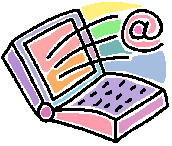|
 

|






 |
This webquest was designed to utilize the knowledge acquired throughout the
semester about PowerPoint and Internet technology. Students will be
asked to select a vacation location and develop a PowerPoint
presentation, along with an itinerary, to promote the area.
They will
be required to: retrieve pictures from the Internet to create the
presentation and itinerary; gather facts about the location; search
travel options using airline, hotel and car rental websites and/or
full service websites; develop a budget on how much it would cost to
travel to the destination; and present their final projects to the
class. This
task utilizes skills learned in other subject
areas, such as: geography, mathematics, reading, and history. |
|
| Background
Information: |
Subject(s):
Technology, Social Studies, Mathematics, English, and Art.
|
Grade/Level:
9-Adult
|
Objective:
To demonstrate their proficiency in PowerPoint, utilize research
skills, have fun, and learn
about an U.S. city/location.
|
Time
Allotment:
10 class periods. 40 minutes per class.
|
| Implementation: |
Learning
Context:
Many activities throughout the semester will proceed this one. It is
expected to be a culmination of previous sub-topics which introduced
the new technology. In addition, the project will allow students to
utilize skills learned in other subject areas, such as: Math,
Geography, English, and Art.
|
Procedure:
Students will be provided two weeks of class time (10 - 40 minute
sessions) to
complete the task. During their class period in the technology
lab they will be expected to utilize the available technology. It is
expected that students will most likely have to send out of class
time to perform
research and gather images/graphics.
During the two weeks students have to complete the project, there
will be check points. The check points are to keep the students on
track, as well as, ensure they are completing the entire task.
They will be as
follows:
 | Day
One – Decided on idea/topic
|
 | Day
Three – Have facts gathered about destination
|
 | Day
Five – Have images gathered
|
 | Day
Seven – Rough draft of PowerPoint presentation and brochure
|
 | Day
Nine – Second review of draft project
|
 | Day
Ten- FINAL presentation and brochure are due
|
|
| Standards
& Assessment: |
| Students
participating in this webquest will meet the New
York State Learning Standards listed below. The standards
addressed by this webquest cover many subject areas.
Skills encouraged by this
webquest include: performing research, critical thinking, creative
problem solving, comparison of evidence, and creative expression.
New York State
Learning Standards:
Subject: Mathematics,
Science, and Technology
 | Standard
2 : Information Systems
Students will access, generate, process, and
transfer information using appropriate technologies.
 | Performance Indicator
: Prepare multimedia presentations demonstrating a
clear sense of audience and purpose. |
 | Performance Indicator
: Access, select, collate, and analyze information
obtained from a wide range of sources such as research data
bases, foundations, organizations, national libraries, and
electronic communication networks, including the Internet. |
 | Performance Indicator
: Use a range of equipment and software to
integrate several forms of information in order to create
good quality audio, video, graphic, and text-based
presentations |
 | Performance Indicator :Understand
the need to question the accuracy of information displayed
on a computer because the results produced by a computer may
be affected by incorrect data entry. |
|
 | Standard 3 : Mathematics
Students will
understand mathematics and become mathematically confident by
communicating and reasoning mathematically, by applying
mathematics in real-world settings, and by solving problems
through the integrated study of number systems, geometry,
algebra, data analysis, probability, and trigonometry.
 | Performance Indicator:
Apply a variety of reasoning strategies |
 | Performance Indicator:
Understand and apply ratios, proportions, and percents
through a wide variety of hands-on explorations |
 | Performance Indicator:
Estimate, make, and use measurements in real-world
situations |
|
 | Standard
5 : Technology
Students will apply technological knowledge and
skills to design, construct, use, and evaluate
products and systems to satisfy human and
environmental needs.
 | Performance
Indicator : Identify, locate, and
use a wide range of information resources including subject
experts, library references, magazines, videotapes, films,
electronic data bases and on-line services, and discuss and
document through notes and sketches how findings relate to
the problem |
 | Performance
Indicator : Select appropriate tools,
instruments, and equipment and use them correctly to process
materials, energy, and information |
 | Performance
Indicator : Explain how computers and
automation have changed the nature of work |
 | Performance
Indicator : Discuss the role technology
has played in the operation of successful U.S. businesses
and under what circumstances they are competitive with other
countries |
 | Performance
Indicator : Explain how technological
inventions and innovations stimulate economic
competitiveness and how, in order for an innovation to lead
to commerical success, it must be translated into products
and services with marketplace demand |
 | Performance
Indicator : Use a computer system
to connect to and access needed information
from various Internet sites.
|
|
 | Standard 7 : Interdisciplinary
Problem Solving
Students will apply the knowledge
and thinking skills of mathematics, science, and technology to
address real-life problems and make informed decisions.
 | Performance Indicator: Make
informed consumer decisions by seeking answers to
appropriate questions about products, services, and systems;
determining the cost/benefit and risk/benefit tradeoffs; and
applying this knowledge to a potential purchase |
 | Performance Indicator: Gather
and process information-Accessing information from printed
media, electronic data bases, and community resources and
using the information to develop a definition of the problem
and to research possible solutions |
 | Performance Indicator: Present
results-Using a variety of media to present the solution and
to communicate the results |
|
Subject: Social
Studies
 | Standard 1:
History of the United States and New York
Students will use a
variety of intellectual skills to demonstrate their
understanding of major ideas, eras, themes, developments, and
turning points in the history of the United States and New York.
 | Performance Indicator: Gather
and organize information about the important achievements
and contributions of individuals and groups living in New
York State and the United States. |
|
 | Standard
3 : Geography
Students will use a variety of intellectual skills
to demonstrate their understanding of the geography
of the interdependent world in which we
live—local, national, and global—including the
distribution of people, places, and environments
over the Earth’s surface.
 | Performance
Indicator : Map information about
people, places, and environments. |
 | Performance
Indicator : Plan, organize, and
present geographic research projects
|
 | Performance
Indicator : Locate and gather
geographic information from a variety of primary and
secondary sources (Taken from National Geography Standards,
1994) |
 | Performance
Indicator : Select and design maps,
graphs, tables, charts, diagrams, and other
graphic representations to present
geographic information.
|
|
Subject: English
Language Arts
 | Standard 1:
Language for Information and Understanding
Students will listen, speak, read, and write for information and
understanding. As listeners and readers, students will collect
data, facts, and ideas; discover relationships, concepts, and
generalizations; and use knowledge generated from oral, written,
and electronically produced texts. As speakers and writers, they
will use oral and written language that follows the accepted
conventions of the English language to acquire, interpret,
apply, and transmit information.
 | Performance
Indicator : Make perceptive and well
developed connections to prior knowledge |
 | Performance
Indicator : Evaluate writing strategies
and presentational features that affect interpretation of
the information |
 | Performance
Indicator : Use standard English
skillfully, applying established rules and conventions for
presenting information and making use of a wide range of
grammatical constructions and vocabulary to achieve an
individual style that communicates effectively |
|
 | Standard 3:
Language for Critical Analysis and Evaluation
Students will
listen, speak, read, and write for critical analysis and
evaluation. As listeners and readers, students will analyze
experiences, ideas, information, and issues presented by others
using a variety of established criteria. As speakers and
writers, they will use oral and written language that follows
the accepted conventions of the English language to present,
from a variety of perspectives, their opinions and judgments on
experiences, ideas, information and issues.
 | Performance
Indicator : Make effective use of
details, evidence, and arguments and of presentational
strategies to influence an audience to adopt their position |
 | Performance
Indicator : Monitor and adjust their own
oral and written presentations to have the greatest
influence on a particular audience |
|
|
|
|
| Technology
Foundation Standards for Students: |
|
|
This WebQuest
satisfies at least one part of each of the six National
Educational Technology Standards for Students.
1.
Basic operations and concepts
 |
Students
demonstrate a sound understanding of the nature and operation of
technology
systems.
|
 |
Students
are proficient in the use of technology |
2.
Social, ethical, and hum issues
 |
Students
understand the ethical, cultural, and societal issues related to
technology.
|
 |
Students
practice responsible use of technology systems, information, and
software.
|
 |
Students
develop positive attitudes toward technology uses that support
lifelong learning, collaboration, personal pursuits, and productivity. |
3.
Technology productivity tools
 |
Students
use technology tools to enhance learning, increase productivity, and
promote creativity. |
 |
Students
use productivity tools to collaborate in constructing
technology-enhanced models, prepare publications, and produce other
creative works. |
4.
Technology communication tools
 |
Students
use telecommunications to collaborate, publish, and interact with
peers, experts, and other audiences.
|
 |
Students
use a variety of media and formats to communicate information and
ideas effectively to multiple audiences. |
5.
Technology research tools
 |
Students
use technology to locate, evaluate, and collect information from a
variety of sources. |
 |
Students
use technology tools to process data and report results.
|
 |
Students
evaluate and select new information resources and technological
innovations based on the appropriateness for specific tasks. |
6.
Technology problem-solving and decision-making tools
 |
Students
use technology resources for solving problems and making informed
decisions.
|
 |
Students
employ technology in the development of strategies for solving
problems in the real world. |
|
|
 Comments or
suggestions, please email Joan
Schildkraut Comments or
suggestions, please email Joan
Schildkraut
|







 Comments or
suggestions, please email Joan
Schildkraut
Comments or
suggestions, please email Joan
Schildkraut
